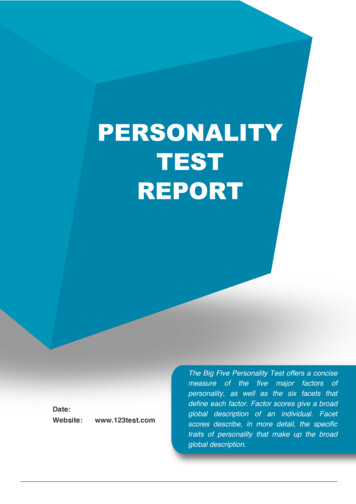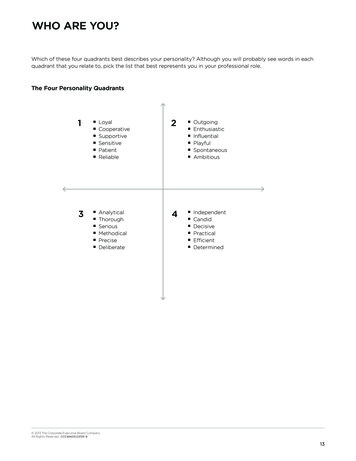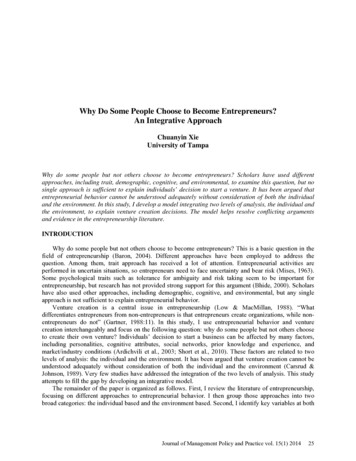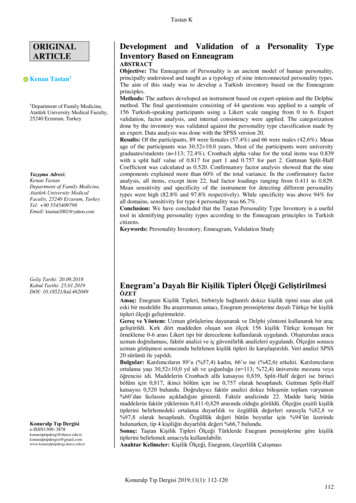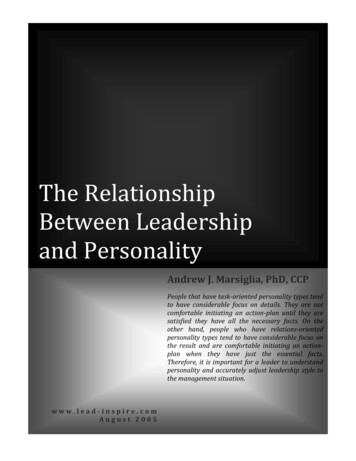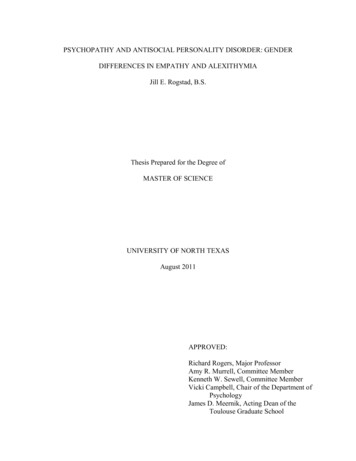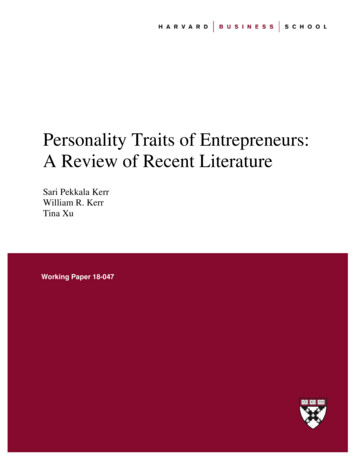
Transcription
Personality Traits of Entrepreneurs:A Review of Recent LiteratureSari Pekkala KerrWilliam R. KerrTina XuWorking Paper 18-047
Personality Traits of Entrepreneurs:A Review of Recent LiteratureSari Pekkala KerrWellesley CollegeWilliam R. KerrHarvard Business SchoolTina XuWellesley CollegeWorking Paper 18-047Copyright 2017 by Sari Pekkala Kerr, William R. Kerr, and Tina XuWorking papers are in draft form. This working paper is distributed for purposes of comment and discussion only. It maynot be reproduced without permission of the copyright holder. Copies of working papers are available from the author.
Personality Traits of Entrepreneurs:A Review of Recent LiteratureSari Pekkala Kerr, Wellesley CollegeWilliam R. Kerr, HBS & NBERTina Xu, Wellesley CollegeNovember 2017Abstract: We review the extensive literature since 2000 on the personality traits of entrepreneurs.We first consider baseline personality traits like the Big-5 model, self-efficacy and innovativeness,locus of control, and the need for achievement. We then consider risk attitudes and goals andaspirations of entrepreneurs. Within each area, we separate studies by the type of entrepreneurialbehavior considered: entry into entrepreneurship, performance outcomes, and exit fromentrepreneurship. This literature shows common results and many points of disagreement,reflective of the heterogeneous nature of entrepreneurship. We label studies by the type ofentrepreneurial population studied (e.g., Main Street vs. those backed by venture capital) toidentify interesting and irreducible parts of this heterogeneity, while also identifying places wherewe anticipate future large-scale research and the growing depth of the field are likely to clarifymatters. There are many areas, like how firm performance connects to entrepreneurial personality,that are woefully understudied and ripe for major advances if the appropriate cross-disciplinaryingredients are assembled.Key Words: Entrepreneurs, venturing, personality traits, characteristics, Big-5, risk attitudes,success, goals, demographics, skillsJEL Codes: L26; D03, D81, D86, M13, O30Acknowledgements: Comments are appreciated and can be sent to skerr3@wellesley.edu. Thisresearch is generously supported by the Alfred P. Sloan Foundation, the Kauffman Foundation,the National Science Foundation, the Smith Richardson Foundation, and Harvard Business School.William Kerr is a Research Associate of the Bank of Finland and thanks the Bank for hosting himduring a portion of this project.1
Table of ContentsIntroduction1. Personality traits1.1 Prevalence of characteristics in entrepreneurs vs. other populations1.1.1 Big-5 model1.1.2 Self-efficacy and innovativeness1.1.3 Locus of control1.1.4 Need for achievement1.2 Correlation of personality traits with venture phases1.2.1 Probability of entry into entrepreneurship1.2.2 Growth and success as an entrepreneur1.2.3 Probability of exiting entrepreneurship1.3 Moderating traits and environmental factors2. Risk attitudes2.1 Methods of measuring risk attitudes2.2 Risk attitudes of entrepreneurs vs. other populations2.3 Effect of risk attitudes in the startup process2.3.1 Probability of entry into entrepreneurship2.3.2 Growth and success as an entrepreneur2.3.3 Probability of exiting entrepreneurship2.4 Entrepreneurial self-efficacy, risk attitudes, and optimism3. Goals and aspirations3.1 Reasons for deciding to start a business3.2 Entrepreneurial goals4. ConclusionsAppendix. Other characteristics of entrepreneursA1.1 DemographicsA1.2 Financial assets and wealthA1.3 Industry experience and educationA1.4 Entrepreneurial regionsOnline Appendix. Detailed survey methodologies and study notesA: Summary tables of studies by topicB: Typical Big-5 inventory utilized in entrepreneurship studiesC: Representative examples of survey questions and measures related to risk attitudes2
IntroductionEntrepreneurial firms and the founders behind these ventures are in vogue everywhere.Cities across the United States are sprouting new incubators and accelerators and introducingprograms to attract innovative talent. Foreign countries are also quite active, with nations rangingfrom China to Chile experimenting in new ways to foster new firm formation. The fascination withentrepreneurs is not brand new, of course, and a literature dating to the 18th century explores whatdrives entrepreneurs and whether their traits matter for the outcomes of their ventures. Thisliterature now spans many fields and has introduced multiple concepts and methods related to theanalysis of entrepreneurial characteristics. In this review, we collect and organize the latestfindings on the prevalence of various personality traits among the entrepreneurial population andtheir impact on venture performance. We cover academic work ranging from economics topsychology to management studies, with a focus on studies published after 2000.Many studies consider the “traits of entrepreneurs” or the “traits that make entrepreneurssuccessful.” As Åstebro et al. (2014) highlight, the publication in 1921 of Frank Knight’s bookRisk, Uncertainty and Profit marked a key launching point into rigorous and careful research onthe personalities of entrepreneurs that set them apart from general business managers. In thedecades that followed, research has continued to investigate specific individual traits that promptpeople to become entrepreneurs, as well as personal motivations and preferences that keepentrepreneurs on their chosen path. These studies have often focused on high-growth settings orfirms financed by venture capital (VC), where entrepreneurs face a high probability of theirbusiness failing, a very small probability of extremely positive outcomes, and a possibly lowaverage return to the monetary and time investments made into their businesses. Standardeconomic theory must be augmented to explain such a pursuit, and many scholars have tried tounderstand the “homo entreprenaurus” (a moniker introduced by Uusitalo, 2001).Yet, the term “entrepreneur” is also applied in academic research to many groups beyondthe founders of Silicon Valley startups. The studies that we document in this review range in termsof their definitions of entrepreneurship to also include creators of “Main Street” small businessesor even young college students attending an entrepreneurship class. While these groups are allconnected to entrepreneurial activity, recent work shows the remarkable degree to which thesesubpopulations behave differently (e.g., Hurst and Pugsley, 2011, Levine and Rubenstein, 2017),and the typical personality traits of individuals will vary greatly by form of entrepreneurial activity.In our review, we attempt to pay close attention to the group under the microscope of each studyand note where subpopulations are generating different results.We conduct this survey with an applied empirical researcher in mind, although we hopethis review is useful for many others too. Applied researchers today have access to data formeasuring entrepreneurship that was unthinkable a decade ago. Most noticeably, researchers cannow utilize large-scale administrative datasets built on employer-employee data to model3
entrepreneurial transitions. Taking the United States as one example, while cutting-edge work inthe 2000s often used firm-level entry rates measured in datasets like the Census of Manufacturesor Venture Xpert, we increasingly have researchers accessing comprehensive panel data onindividuals like the Linked Employer-Household Database to model entrepreneurial transitions.Other countries further hold frontier administrative datasets that combine founding behavior withanything from the prescription drug histories of individuals to their stock portfolios. Beyondadministrative datasets, researchers now build their own specialized datasets: tracking cohortsfrom entrepreneurial training programs; accessing gig economy transactions from a leading onlineplatform; crafting from LinkedIn profiles of entrepreneurs receiving venture financing; conductingcustomized surveys of entrepreneurs in co-working spaces; and much more. This wealth ofopportunity has led to a flowering of research that measures career histories and individual-leveltraits that predict entrepreneurship.While these frontier datasets afford opportunities to ask exciting new questions, researchersmust also confront new challenges. As one considers individual-level factors that promote entry,questions arise as to when and how the personalities of founders should be considered. Some aredirectly interested in the phenomenon, wanting to study for example the risk tolerance of foundersof high-growth startups. For others, the research question lies elsewhere, but there is a worry aboutpersonality being an important omitted factor that biases empirical results. For yet others,personality could be the channel or mechanism through which some studied events produce shortand long-run effects. While some classic studies have looked at how personality traits impacttransitions into self-employment, this new work covers a much broader and more heterogeneousterrain, ranging from the opening of small-scale service businesses to high-growthentrepreneurship. As the options continue to proliferate for modeling individual- and team-levelentrepreneurship, it becomes more important to have a perspective of the personality traitsassociated with entrepreneurship and how they influence the research being conducted.Three decades ago, in a very influential article, Gartner (1988) criticized the study ofentrepreneurial personality traits, arguing instead for a focus on how organizations emerge.Gartner disapproved of the varying definitions being used for entrepreneurship, preferring to focuson a definition that emphasized the functional creation of new organizations. Gartner alsoquestioned collecting traits of entrepreneurs using survey methodologies to discern an “ideal”personality for entrepreneurial performance. The shadow of this critique has been on the literaturefor a long time, and it is far from clear that these new efforts will overcome the challenges thatGartner (1988) outlined, as we re-surface many of these same challenges throughout this review.Yet, the better recognition of heterogeneity among entrepreneurs and powerful new data sourcessuggest it might be fruitful to reexamine some of these areas again, some 30 years later. After all,the focus for many is now on describing how personality may influence the creation of neworganizations, addressing at least some of Gartner’s concern.4
We focus our survey on three core themes: (1) the personality traits of entrepreneurs andhow they compare to other groups; (2) the attitudes towards risk that entrepreneurs display; and(3) the overall goals and aspirations that entrepreneurs bring to their pursuits. These themescover most of the main theoretical contributions to the entrepreneurial traits literature, which arequite diverse, while at the same time enabling the identification of common concerns acrossapparently separate research streams. There are some personality traits and cognitive biases thatwe spend less time on, such as over-confidence and how it differs from risk attitudes. This wasnot due to a prejudice against these traits, but mainly the literature-driven foundation of ourinquiry that we describe in the next section. With a few exceptions, we concentrate on empiricalstudies and meta reviews of them to give a flavor of the recent applied work in this field,spending limited time on lab or experimental studies.An appendix to our survey provides a short discussion of some major factors influencingentrepreneurial decisions beyond personality: demographics, household assets and financingconstraints, measurable skills like work experience and education, and local environment. Thisauxiliary discussion is short and far from comprehensive, meant only to provide some backgroundhelpful for understanding the “soft data” covered in this review and how they interact. For thoseinterested in measuring entrepreneurial risk attitudes and personality traits in their own work, anadditional online appendix documents some of the survey instruments commonly utilized. Thisappendix also provides more detailed notes on the research papers that we review.We do not pretend to uncover a once-and-for-all synthesis with this review, and nor do wepretend to resolve longstanding debates like whether entrepreneurs are “born or made.” Theheterogeneity across entrepreneurs within just Cambridge, Massachusetts suggests that a uniqueset of factors does not exist, much less the vast differences in entrepreneurial pursuits acrosscountries, industries, and similar. Few applied researchers when confronted with massiveempirical datasets would even contemplate such grandiose aims. Instead, we provide a unifieddiscussion of the vast body of research related to these three key topics and embrace theheterogeneity where it exists. An accurate and unvarnished depiction of the variance in studies isimportant for contemplating how academic work can provide better empirical insights that informentrepreneurship training programs, policy initiatives designed to bolster startup activity, and soon.In our opinion, the state-of-the art study on entrepreneurial characteristics is one that (1)utilizes longitudinal data on a large and representative sample of individuals, (2) measurespersonality traits before entry decisions are made, and (3) carefully measures individual traits suchas risk aversion and entrepreneurial self-efficacy. These conditions are necessary for statisticallyprecise comparisons of entrepreneurs to other employee and managerial groups, better insight intodifferences across types of entrepreneurs (e.g., self-employed vs. growth-oriented employers), andin-depth analysis of subsequent startup performance. The literature is especially weak on this5
performance dimension. These conditions are not sufficient for assigning causal roles forpersonality traits—a very daunting task—but they are probably necessary ingredients. Ahn (2010)and Levine and Rubenstein (2017) are examples of innovative and impressive studies that utilizethe National Longitudinal Survey of Youth (NLSY), although the NLSY’s small sample generatesconstraints. Hvide and Panos (2014) and Caliendo et al. (2014) also show frontier examples thatbuild upon longitudinal administrative records and national surveys. Even with this gold standardin mind, the practical limits of building such platforms—especially the off-the-shelf tradeoff ofusing administrative records that provide universal employment histories but limited collection ofpersonality traits—suggest that there is still much to gain from carefully conducted surveys thatfocus on narrow and clearly specified groups of interest and define a relevant comparison groupthat entrepreneurs are contrasted with.We hope this survey provides a useful input into several complementary streams of work.There are often four-fold or larger differences in entrepreneurship rates across U.S. cities (e.g.,Glaeser et al., 2015), and those for venture capital are even sharper (e.g., Samila and Sorenson,2011). Moreover, the rate of new business formation is declining in the United States (e.g., Deckeret al., 2014). Many business leaders and policy makers are looking to build better environments tosupport entrepreneurship, and this review highlights softer personality traits and risk attitudes thatcan be considered along with more typical factors like financing conditions. As Chatterji et al.(2014) describe, successful interventions to build the entrepreneurial base need to activate the localpopulation, versus just relying on attracting entrepreneurs from afar, and research on these softerelements is of first-order importance in designing quality initiatives and policy experiments.The findings related to personality characteristics and other attributes of entrepreneurs, aswell as the correlation of those characteristics with business performance, also imply that theremay be scope for including some personality development modules in entrepreneurship education.Many academic institutes have introduced entrepreneurship training, ranging from high schools toexecutive programs, but these programs have to date focused more on hard skills rather thanpersonality mapping and softer preparations. While some personality traits are fixed, Rauch (2014)provides some examples of how, for example, self-efficacy and achievement motivation can beinfluenced with relatively simple interventions. A clearer understanding of the specific traits ofentrepreneurs and their heterogeneity may help to better match potential entrepreneurs to settingsthat are most closely aligned with their strengths.Finally, we hope to connect to future academic work. There are very few scholars in thediverse entrepreneurial literature that regularly read the full range of academic output describedbelow, much less utilize it in shaping their own research (including ourselves). Yet, these interfacesare precisely where we need the most urgent attention. To give an example, the very sparse numberof studies that connect firm performance outcomes to the personality traits of entrepreneurs are asignificant limitation to our capacity to describe the quality margin of entrepreneurial ideas.6
Applied microeconomics researchers that utilize administrative and longitudinal data have anexcellent toolkit to model these startup outcomes, but they are among the least exposed to the latestperspectives on personality traits. A goal of this survey is to help close these information gaps andencourage more cross-disciplinary work in this area.1. Personality traitsResearch on the personality traits of entrepreneurs took off in the mid-20th century,unifying approaches from economics, psychology, sociology, and business management to answerthe questions: Who is an entrepreneur? What drives them? What traits define them? The first fewdecades faced many conceptual challenges as researchers struggled to develop a solid theoreticalframework and appropriate measurement tools. In 1971, economist Peter Kilby famouslycompared the entrepreneur to A.A. Milne’s Heffalump, a fictional elephant that all investigatorsapproached with improvised proxies from their disciplines, each asserting that they had discoveredthe ever-elusive creature’s behavior. 1 In the 1980s, this discordance in the literature led someresearchers to conclude that there was no correlation between personality and entrepreneurship(e.g., Brockhaus and Horwitz, 1986; Gartner, 1988).0FHowever, since the start of the 21st century and with the notable rise of public andintellectual fascination with startup culture, the entrepreneurial personality literature has enjoyeda resurgence and convergence toward an increasingly consistent set of theoretical frameworks,with meaningful insights toward innovation policy and business education. The bulk of recentliterature seeks to answer two main questions: (1) Do certain traits predict an individual’slikelihood of becoming an entrepreneur, and (2) Do certain traits predict an entrepreneur’slikelihood of achieving “successful” outcomes? These answers are pursued by investigating theprevalence of personality characteristics in entrepreneurs versus other populations, as well as byanalyzing the correlation of these characteristics with entrepreneurial performance factors such asbusiness survival and growth (e.g., Baron, 2004).While personality theory remains rife with its own set of contentions, researchers haveprimarily gravitated over the last few decades to the Big-5 factor personality model. Severaladditional traits have been fused into the Big-5 for entrepreneurial work, including self-efficacy,innovativeness, locus of control, and risk attitudes (which we reserve for individual discussion inthe second part of this literature review). Researchers often mix and match these traits to describea multidimensional “entrepreneurial orientation.” In this literature review, we mostly focus ourdiscussion on literature published after 2000 to detail the newest wave of personality research andthe cutting-edge questions. Rauch et al. (2009), Rauch (2014) and Patterson and Kerrin (2014)provide reviews of some of the seminal contributions that came earlier.1Kilby (1971) and A.A. Milne, Winnie the Pooh (1926) and The House at Pooh Corner (1928).7
1.1 Prevalence of personality traits in entrepreneurs vs. other populationsMany researchers compare the traits of entrepreneurs to employed workers or the generalpopulation to identify characteristics that define entrepreneurs as a group. It may seem a foolish orunnecessary task to compare Steve Jobs or Elon Musk to the average person, and many booksdescribe the special biographies and personalities of these great entrepreneurs. Here, however, theliterature has a very different focus. For every Jobs or Musk, we have thousands of entrepreneursseeking growth-oriented businesses and many more seeking to build a business for themselves asself-employed proprietors. The collective impact of these individuals on our economy is enormous,even if they don’t start Apple or SpaceX. This literature is concerned with investigating anddefining the regularities and differences in the personalities of these entrepreneurs.For this review, we combed through hundreds of studies on J-Stor, Econstor, and the online journal databases available at Harvard Business School and Wellesley College, coveringjournal articles and dissertations spanning economics, psychology, and management studies. Werestricted our focus to articles published after 2000, as a resurgence of interest into entrepreneurialbehavior generated a new crop of studies that had not been meaningfully summarized. Data usedin the studies came from the United States, Canada, Australia, New Zealand, Germany, France,Italy and other European economies. We considered articles with various definitions ofentrepreneurs, most commonly self-employed individuals or business owner-managers. Weexcluded studies looking solely at subsistence entrepreneurship, partially because these studies areso sparse. Many of the personality questionnaires were conducted with business-track universitystudents, while other studies used national data sets including all fields and industries ofemployment. While Frese (2009) highlights how entrepreneurial action extends to efforts beyondfor-profit firm creation (e.g., social activism), we focus this survey on the venture creation processin the private sector. We purposefully spend less time on the variations of overconfidence,optimism, and risk taking given the detailed recent review of Åstebro et al. (2014) on these issues.Studies on risk attitudes were searched using the keywords “risk preference,” “riskpropensity,” “risk aversion,” and “risk tolerance.” We included risk measures of various kinds,including self-reported answers in longitudinal surveys, hypothetical gambling situations, andinvestment history metrics. Studies on personality traits were searched using keywords such as“personality,” “traits,” and “orientation,” as well as the specific trait names covered in this survey.We included the most commonly used personality concepts (Big-5, need for achievement, internallocus of control, innovativeness, and self-efficacy). In a few studies that used composite measuresof “entrepreneurial orientation,” we turned to the reported underlying data for disaggregation ofindividual variables. We excluded personality traits for which there was too little literature tosummarize meaningfully: need for autonomy, stress/uncertainty tolerance, tenacity, self-esteem,discipline, delay of gratification, and so on.8
After combing through research databases for the relevant and academically rigorousarticles, we compiled them into a set of tables (contained in the online appendix). The first seriesof tables list studies by risk attitudes (28 studies). The second series list studies by personalitytraits: Big-5 (10), need for achievement (12), locus of control (13), self-efficacy/proactivity (11),innovativeness (12), stress/uncertainty tolerance (4) and need for autonomy (4). The third serieslist studies by the stage of business they apply to: career choice/business creation (14),survival/success (14), and exit (1). The final series list studies by other types of comparisons:comparing demographics (11) and comparing with environmental factors (6). These tables formthe starting point of our summary of each subset of literature, as well as comparisons on themethodologies, conceptual tools, findings, and efficacy of each approach.Before reviewing these studies, it is important to identify broad caveats and limitations tothis literature stream. First, many studies lack the preferred structure outlined in the Introduction,with the unfortunate result that it is often unclear as to whether individuals with a given set ofpersonality traits selected into entrepreneurship, or whether the traits were developedendogenously by individuals after becoming entrepreneurs. This reverse causality concern isespecially prominent for cross-sectional surveys and data tabulations. Additionally, even when themeasurement of personality traits does precede entrepreneurial choices, this does not guaranteethat this trait was the causal factor. For example, individuals from wealthy families may score highon risk tolerance levels because they have the security of their family’s money, and perhapsavailability of financial resources is the true factor that prompts entrepreneurship, independent ofrisk tolerance. Without observing and measuring the wealth of individuals, we are liable tomismeasure the role of risk tolerance for decisions. This concern over omitted variable bias is truefor individual studies, and it is compounded when comparing studies drawn from countries andsettings that have differing cultural factors that are also known to influence personality traits, suchas entrepreneurial motivation and achievement orientation (Stewart and Roth, 2007). Finally,survey-based analyses often have small sample sizes, which may explain some of the variation inresults seen across studies.Understanding these caveats, we proceed with a summary of the main personality-relatedresults. The online appendix to this review contains additional details for most of the papersmentioned. The collected information includes country of coverage, personality traits anddemographics considered, measurement approach, data sources and sample size, outcomes andfindings (including reference group), and the population of entrepreneurs considered. While firstdeveloped for our own use, we hope this is a useful resource for those wishing to dig deeper onthese diffuse literatures.9
1.1.1 Big-5 modelThe Big-5 model is a multidimensional approach towards defining personality, throughmeasuring openness, conscientiousness, extraversion, agreeableness, and neuroticism. It has beenthe predominant model for personality traits since the 1980s, and the Big-5 traits have been foundto influence career choice and work performance (e.g., Costa and McCrae, 1992; Digman, 1990;Goldberg, 1990; John et al., 2008; Rauch, 2014). The five “macro traits” cover a distinct set ofcharacteristics, as described in John et al. (2008, p. 138): Openness to experience: describes the breadth, depth, originality, and complexityof an individual’s mental and experimental life Conscientiousness: describes socially prescribed impulse control that facilitatestask- and goal-orientated behavior Extraversion: implies an energetic approach toward the social and material worldand includes traits such as sociability, activity, assertiveness, and positiveemotionality Agreeableness: contrasts a prosocial and communal orientation toward others withantagonism and includes traits such as altruism, tender-mindedness, trust, andmodesty Neuroticism: contrasts emotional stability and even-temperedness with negativeemotionality, such as feeling anxious, nervous, sad, and tenseDifferences between entrepreneurs and managersThe bulk of the existing studies comparing the prevalence of Big-5 traits betweenpopulations of entrepreneurs and managers occurred between 1960 and 2000. Managers arefrequently used as a comparison point for entrepreneurs given the potential need of both groups todirect workers and manage multiple tasks. In a meta-analysis of 23 studies conducted from 1970to 2002 in a variety of countries and reported in English-language journals, Zhao and Seibert(2006) find entrepreneurs to be more open to experience, more conscientious, similar forextraversion, less agreeable, and less neurotic (or in the Big-5 lingo, O , C , E, A-, N-). Manyindividual studies, of course, show deviations from this pattern. For example, in a survey by Envickand Langford (2000) of 218 entrepreneurs and managers in a large Canadian city, the authors findentrepreneurs to be significantly less conscientious and agreeable than managers and lessextraverted (O , C-, E-, A-, N-), while confirming the other patterns observed in the meta study.These characteristic differences between entrepreneurs and the average employed personare often theoretically ascribed to the “attraction-selection-attrition model” (Schneider, 1987).According to this model, workers are attracted to jobs whose demands and opportunities matchtheir talents, motives, and personality traits; employers or financiers then select applicants whoseaptitudes and motives fit their criteria; and workers then stay in their occupational group when10
they find their professional situation more rewarding than alternative positions. We review nexteach of these five traits as they would be presented in this model.Entrepreneurs are consistently found to be more open to experience than managers (O ).Researchers hypothesize that in the context of a business venture, an
personality could be the channel or mechanism through which some studied events produce short - and long-run effects. While some classic studies have looked at how personality traits impact t

